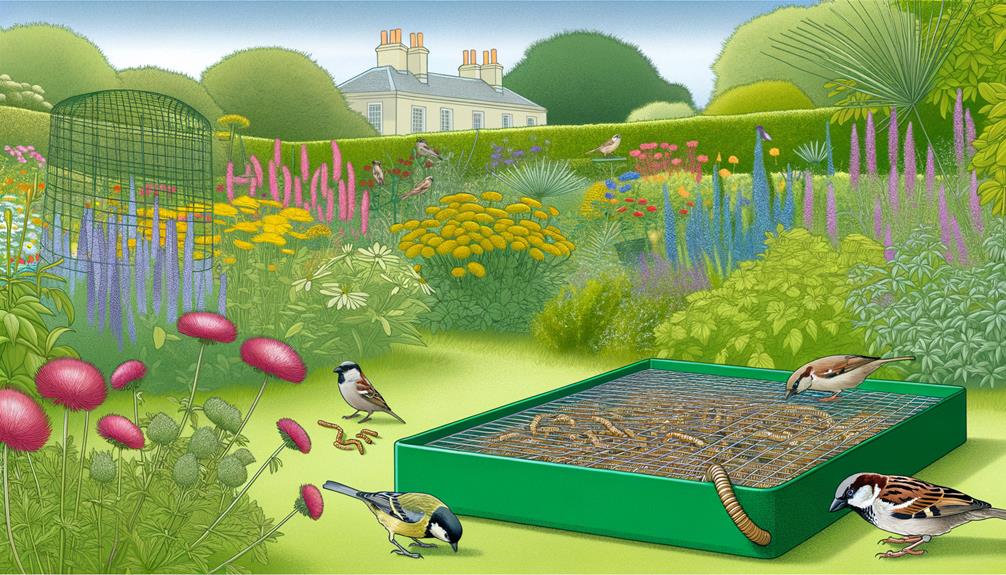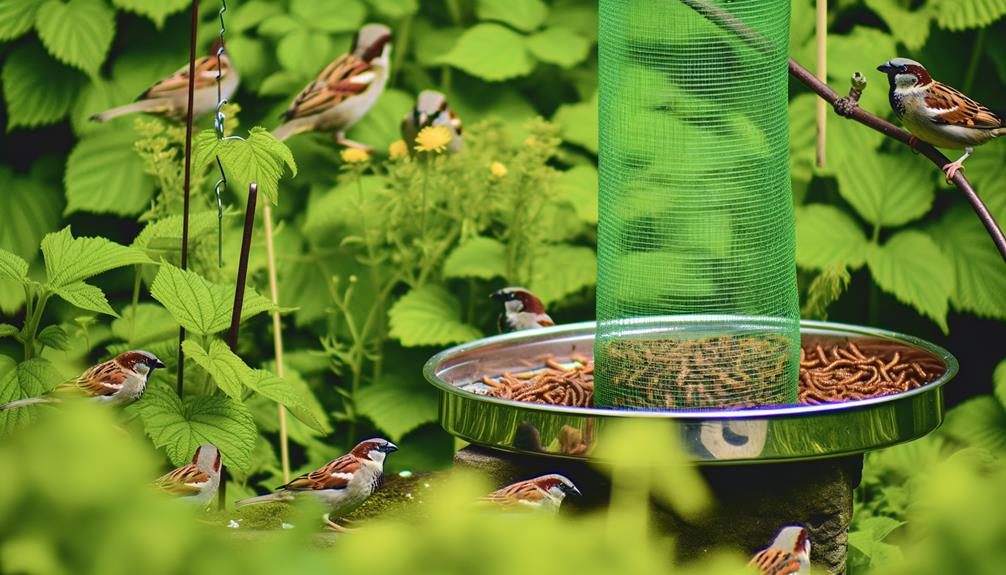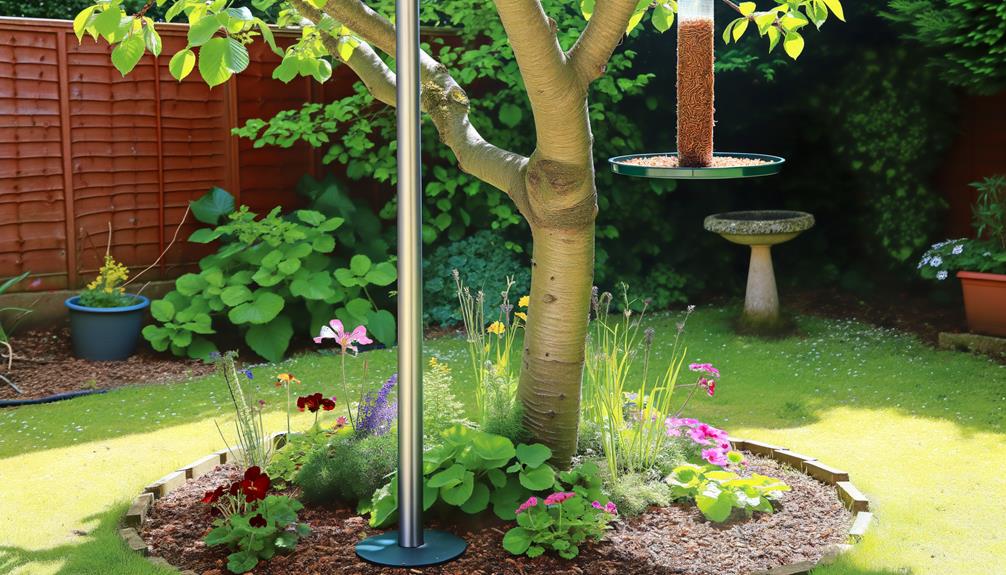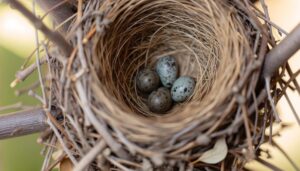7 Steps to Keep Sparrows Out of Your Mealworm Feeder Tray
To keep sparrows out of mealworm feeder trays, implement several specific strategies. Utilize feeders with smaller entrance holes and tight mesh guards to limit sparrow access.
Employ perch restrictors to reduce landing space for larger birds and calibrate weighted feeders that close under excessive weight to target lighter species. Enhance effectiveness with reflective tape or predator decoys to disorient or deter sparrows.
Employ ultrasonic devices emitting distress calls to exploit avian sensitivity and avoid habituation by varying frequencies. Regular feeder maintenance, such as thorough cleaning and structural inspection, is essential.
Discovering additional methods will strengthen your bird feeding success.

Key Takeaways
- Use weighted feeders calibrated to exclude heavier sparrows by closing feeding ports under their weight.
- Install perch restrictors with narrow, adjustable perches to limit sparrow access while favoring smaller birds.
- Implement metal mesh guards with apertures less than 1.5 inches to prevent sparrow entry.
- Utilize reflective tape and predator decoys to create visual deterrents that discourage sparrow activity.
- Conduct regular feeder maintenance, including cleaning and inspections, to minimize debris and maintain feeder integrity.
Understanding Sparrow Behavior

Sparrows, frequently observed for their opportunistic feeding habits, exhibit a high degree of adaptability in exploiting various food sources, including mealworm feeders. These small passerine birds display a remarkable foraging flexibility, driven by both innate and learned behaviors.
Studies indicate that sparrows adjust their feeding strategies based on food availability and competition pressures. They are known to employ keen observational skills to identify and exploit new food sources rapidly. Detailed ethological analyses reveal that sparrows utilize social learning, often mimicking the feeding behaviors of conspecifics.
This adaptability ensures their survival across diverse habitats, but it also poses challenges for those aiming to attract specific avian species to feeders. Understanding these behaviors is vital for devising effective measures to deter them.
Choosing the Right Feeder
Selecting an appropriate feeder is essential for minimizing sparrow interference in mealworm feeding. Research indicates that feeders with specific design features, such as adjustable feeding ports and protective mesh, are effective in deterring sparrows while allowing access to target species.
Additionally, the material composition and durability of the feeder should be considered, with stainless steel and UV-resistant plastics offering longevity and resistance to weather-induced wear.
Feeder Design Features
When determining the best feeder design to exclude sparrows while accommodating desired species, it is essential to take into account specific structural elements such as entrance size, perch configuration, and material durability. Research indicates that feeders with smaller entrance holes can effectively deter sparrows, as these birds typically require larger openings.
Additionally, perch design plays a vital role; shorter perches or those positioned closely to the feeder can make it more challenging for sparrows to land and feed. Observational studies have shown that certain species, like bluebirds, are more adaptable to these configurations.
Ensuring feeder designs incorporate these features can greatly enhance the selective feeding process, thereby promoting the presence of preferred bird species while minimizing sparrow intrusion.
Material and Durability
In addition to feeder design features, the selection of materials and the overall durability of mealworm feeders are critical factors in ensuring long-term functionality and resistance to sparrow interference. Materials should be robust, weather-resistant, and easy to clean to maintain ideal hygiene and prevent bacterial growth.
Research suggests the following materials for their durability and effectiveness:
- Stainless steel: Resistant to rust and corrosion, ensuring longevity.
- Polycarbonate plastic: High impact resistance and UV stability.
- Powder-coated metal: Added layer of protection against environmental elements.
- Wood treated with non-toxic sealants: Offers a natural aesthetic while resisting decay.
These materials not only enhance the feeder's lifespan but also reduce maintenance efforts, ensuring a more efficient feeding environment for intended avian species.
Using Feeder Guards

Feeder guards, constructed from materials such as metal mesh or plastic, can effectively exclude sparrows while allowing access to desired species like bluebirds. Research indicates that the mesh size and material rigidity play pivotal roles in determining the efficacy of feeder guards.
Metal mesh with apertures less than 1.5 inches is particularly effective, as it prevents larger birds from accessing the mealworms. Observational studies have demonstrated that bluebirds, with their slender bills and smaller size, can easily navigate these barriers.
Additionally, plastic guards, although less durable, offer flexibility in design and ease of installation. The differential access provided by these guards not only minimizes competition but also mitigates the risk of feeder monopolization by more aggressive species like sparrows.
Installing Perch Restrictors
Effectively deterring sparrows from mealworm feeders can be achieved by installing perch restrictors, which limit the landing space available to larger, more aggressive birds. This approach employs physical barriers to selectively permit access to smaller, desired species. Research indicates that perch restrictors can be highly effective in minimizing non-target bird intrusion.
Several design variations are available:
- Adjustable perch lengths: Allows customization of landing space.
- Narrow perches: Uncomfortable for larger birds.
- Perch angle modifications: Create unstable landing zones.
- Barrier placement: Strategically positioned to obstruct larger birds.
These modifications optimize feeder accessibility for smaller birds while reducing sparrow presence. Employing perch restrictors enhances feeding efficiency and minimizes resource competition, thereby fostering a balanced avian ecosystem.
Opting for Weighted Feeders

Opting for weighted feeders offers a scientifically validated method to restrict access to mealworms by utilizing mechanisms that close feeding ports under the weight of larger birds, ensuring that only smaller, target species can feed.
These feeders are calibrated carefully to respond to the differential mass between smaller birds such as bluebirds and larger, opportunistic species like sparrows.
Research has shown that these feeders can effectively reduce non-target species visitation by up to 75%.
The design incorporates adjustable springs or counterweights that can be fine-tuned to specific avian weight ranges.
Field studies confirm that the use of weighted feeders notably enhances selective feeding, promoting a more efficient and targeted feeding strategy for desirable bird populations.
Providing Alternative Food Sources
By strategically offering alternative food sources, such as millet and cracked corn, it is possible to divert sparrows away from mealworm feeders, thereby reducing competition for the target species. This method leverages the specific dietary preferences of sparrows, encouraging them to consume more accessible options.
Observations have shown:
- Millet: Highly favored by sparrows due to its small size and nutritional composition.
- Cracked Corn: Serves as an attractive, cost-effective alternative that fulfills sparrows' caloric needs.
- Black Oil Sunflower Seeds: Though not a primary deterrent, these seeds can supplement sparrows' diet.
- Safflower Seeds: Typically less appealing to sparrows, but can still offer variety and attract other avian species.
These alternatives, based on empirical research, effectively manage sparrow presence around mealworm feeders.
Adjusting Feeder Placement

Strategically adjusting the placement of mealworm feeders can decrease sparrow interference to a large extent, as research indicates that feeder height, location, and surrounding environment play crucial roles in avian feeding behavior. Raising feeders to an ideal height (approximately 6-7 feet) can discourage sparrows while accommodating desired species like bluebirds. Moreover, placing feeders in open areas rather than near dense foliage can restrict access for sparrows, who prefer cover. Observational data shows that sparrows are less likely to approach feeders placed in exposed locations.
| Feeder Placement Variable | Impact on Sparrow Presence |
|---|---|
| Feeder Height (6-7 feet) | Decreased interference |
| Proximity to Foliage | Increased interference |
| Open Area Placement | Decreased interference |
| Near Human Activity | Variable impact |
Adjusting these variables can greatly improve feeding efficiency for target species.
Utilizing Visual Deterrents
Utilizing visual deterrents such as reflective tape strips and predator decoy placement has been shown to reduce sparrow activity around mealworm feeder trays. Reflective tape generates light flashes that can disorient and deter sparrows, while strategically placing predator decoys mimics natural threats, thereby discouraging sparrows from approaching.
Both methods have demonstrated efficacy in field studies, providing a non-invasive solution to manage unwanted avian visitors.
Reflective Tape Strips
Reflective tape strips serve as an effective visual deterrent by leveraging sparrows' inherent aversion to sudden flashes of light and movement. Scientific observations indicate that these strips create an environment perceived as unstable and intimidating to sparrows, dissuading their presence.
The efficacy of reflective tape strips is supported by research demonstrating their usefulness in bird control applications. When strategically placed, they can noticeably reduce sparrow activity around mealworm feeder trays.
Key considerations for implementation include:
- Placement: Position strips where they catch maximum sunlight.
- Material: Use high-quality, weather-resistant reflective tape.
- Movement: Ensure strips can flutter freely to enhance visibility.
- Frequency: Regularly inspect and replace worn-out strips to maintain effectiveness.
Understanding these factors can optimize the use of reflective tape strips as a sparrow deterrent.
Predator Decoy Placement
Building on the effectiveness of reflective tape strips, predator decoy placement offers another scientifically-supported method to deter sparrows from mealworm feeder trays by leveraging their instinctual fear of potential threats.
Strategic positioning of decoy predators, such as plastic owls, hawks, or snakes, has been documented to elicit avoidance behaviors in sparrows. Research indicates that these decoys should be periodically relocated to maintain their importance, as static placements may lead to habituation, diminishing their deterrent value.
Observational studies suggest that incorporating movement, such as wind-activated elements, can enhance the perceived threat level, thereby increasing the deterrent effect. Ensuring the decoys are highly visible and realistic in appearance is essential for maximizing their impact on sparrow behavior.
Implementing Sound Deterrents

Implementing sound deterrents, such as ultrasonic devices or distress calls, has been shown through various studies to effectively reduce sparrow activity around mealworm feeders. These auditory deterrents exploit the avian sensitivity to specific frequencies and distress signals, prompting sparrows to avoid the area. Research indicates that consistent use of sound deterrents can notably decrease unwanted sparrow presence.
Key insights include:
- Ultrasonic Devices: Emit high-frequency sounds imperceptible to humans but disturbing to birds.
- Distress Calls: Playback of recorded sparrow distress calls can create an environment perceived as hazardous.
- Frequency Modulation: Varying the frequency prevents habituation.
- Strategic Placement: Positioning devices near feeders maximizes effectiveness.
These methods, grounded in ornithological studies, offer a scientifically validated approach to managing sparrow populations.
Regular Maintenance Tips
Regular maintenance of the mealworm feeder tray is important to guarantee its best functionality and effectiveness in deterring sparrows. Frequent cleaning is necessary to prevent the buildup of debris and pathogens, which could compromise the health of the desired bird species.
Additionally, routine inspections for structural damages are vital to sustain the integrity of the feeder and to prevent sparrows from exploiting any weaknesses.
Clean Feeder Frequently
Frequent cleaning of the mealworm feeder tray is crucial to prevent the accumulation of detritus that can draw in sparrows and other unwanted pests. Regular maintenance guarantees the feeder remains an inhospitable environment for these birds, safeguarding mealworms for intended avian species.
Research indicates that sanitation reduces microbial growth and pest attraction. Employ the following steps for effective maintenance:
- Disassemble the feeder components thoroughly to access all areas.
- Scrub with a gentle detergent solution to eliminate residues.
- Rinse with fresh water to make sure no soap remains, which could be harmful to birds.
- Dry completely before reassembly to discourage mold and mildew growth.
These practices create a cleaner feeding environment, promoting health and deterring sparrows effectively.
Check for Damages
Ensuring the mealworm feeder tray is free from damages is important, as even minor cracks or wear can provide entry points for sparrows and compromise the feeder's integrity.
Conduct a thorough inspection of the feeder tray at least biweekly, focusing on areas prone to stress such as joints and edges. Utilize a magnifying glass to detect micro-cracks and structural weaknesses.
Research indicates that UV radiation and fluctuating temperatures accelerate material degradation, particularly in plastic feeders. Apply a non-toxic sealant to minor fissures and replace components beyond repair.
Document observations systematically to track wear patterns over time. Regular maintenance not only prolongs feeder lifespan but also enhances its efficacy in deterring unwanted avian intruders.
Conclusion
In sum, the integration of behavioral insights, strategic feeder selection, and various deterrent mechanisms fosters an environment where mealworm feeders are less accessible to sparrows.
These methodologies, grounded in ornithological research, not only safeguard the intended avian species but also maintain ecological balance.
The meticulous application of such techniques, akin to a symphony orchestrated by nature's principles, underscores the importance of informed intervention in avian feeding practices, ensuring a harmonious coexistence within backyard ecosystems.






